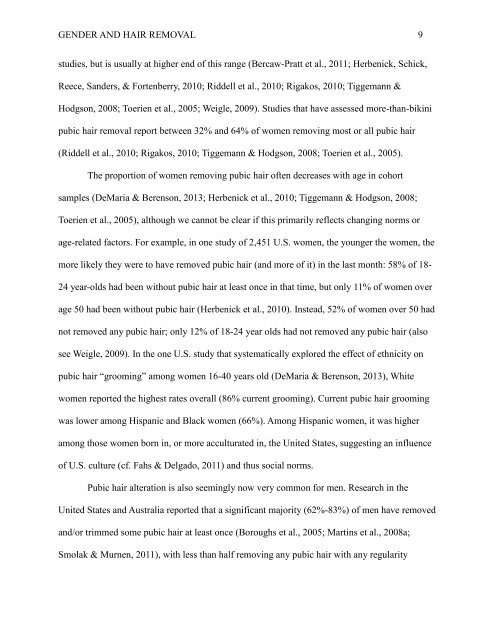Braun, V. , Tricklebank, G. and Clarke, V. (2013) It shouldnt stick out ...
Braun, V. , Tricklebank, G. and Clarke, V. (2013) It shouldnt stick out ...
Braun, V. , Tricklebank, G. and Clarke, V. (2013) It shouldnt stick out ...
Create successful ePaper yourself
Turn your PDF publications into a flip-book with our unique Google optimized e-Paper software.
GENDER AND HAIR REMOVAL 9<br />
studies, but is usually at higher end of this range (Bercaw-Pratt et al., 2011; Herbenick, Schick,<br />
Reece, S<strong>and</strong>ers, & Fortenberry, 2010; Riddell et al., 2010; Rigakos, 2010; Tiggemann &<br />
Hodgson, 2008; Toerien et al., 2005; Weigle, 2009). Studies that have assessed more-than-bikini<br />
pubic hair removal report between 32% <strong>and</strong> 64% of women removing most or all pubic hair<br />
(Riddell et al., 2010; Rigakos, 2010; Tiggemann & Hodgson, 2008; Toerien et al., 2005).<br />
The proportion of women removing pubic hair often decreases with age in cohort<br />
samples (DeMaria & Berenson, <strong>2013</strong>; Herbenick et al., 2010; Tiggemann & Hodgson, 2008;<br />
Toerien et al., 2005), although we cannot be clear if this primarily reflects changing norms or<br />
age-related factors. For example, in one study of 2,451 U.S. women, the younger the women, the<br />
more likely they were to have removed pubic hair (<strong>and</strong> more of it) in the last month: 58% of 18-<br />
24 year-olds had been with<strong>out</strong> pubic hair at least once in that time, but only 11% of women over<br />
age 50 had been with<strong>out</strong> pubic hair (Herbenick et al., 2010). Instead, 52% of women over 50 had<br />
not removed any pubic hair; only 12% of 18-24 year olds had not removed any pubic hair (also<br />
see Weigle, 2009). In the one U.S. study that systematically explored the effect of ethnicity on<br />
pubic hair “grooming” among women 16-40 years old (DeMaria & Berenson, <strong>2013</strong>), White<br />
women reported the highest rates overall (86% current grooming). Current pubic hair grooming<br />
was lower among Hispanic <strong>and</strong> Black women (66%). Among Hispanic women, it was higher<br />
among those women born in, or more acculturated in, the United States, suggesting an influence<br />
of U.S. culture (cf. Fahs & Delgado, 2011) <strong>and</strong> thus social norms.<br />
Pubic hair alteration is also seemingly now very common for men. Research in the<br />
United States <strong>and</strong> Australia reported that a significant majority (62%-83%) of men have removed<br />
<strong>and</strong>/or trimmed some pubic hair at least once (Boroughs et al., 2005; Martins et al., 2008a;<br />
Smolak & Murnen, 2011), with less than half removing any pubic hair with any regularity

















